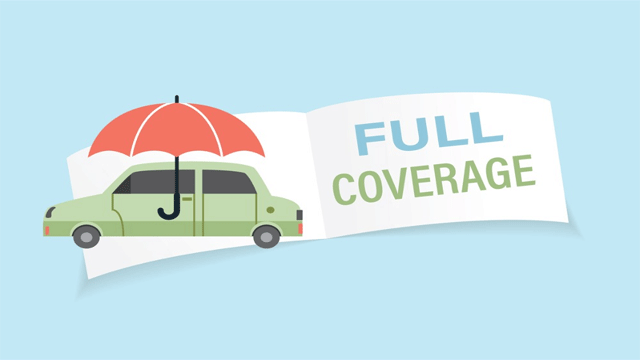Full-Coverage Car Insurance (2024)
Full-Coverage Car Insurance -In the world of car ownership, few things are more important than proper insurance. It protects you financially in case of accidents, thefts, and other unforeseen events. But with various insurance options available, navigating the choices can be confusing. One term you’ll likely encounter is “full-coverage car insurance.” While it sounds straightforward, there’s more to it than meets the eye. This article dives deep into full-coverage car insurance, explaining its components, benefits, and factors to consider before getting it.
What is Full-Coverage Car Insurance?
First things first, “full coverage” isn’t an official insurance term. It’s a general term used by insurers and consumers to describe a policy that combines two main types of coverage:
- Liability Coverage: This protects you from financial responsibility if you cause an accident and injure someone else or damage their property. It covers medical expenses, lost wages, and property repair costs of the injured party. Minimum state-mandated liability limits exist, but you can opt for higher coverage for greater protection.
- Coverage for Your Own Vehicle: This covers repairs to your car in various situations, not just accidents you cause. It typically includes two parts:
- Collision Coverage: Pays for repairs to your car if it collides with another vehicle or object, regardless of fault.
- Comprehensive Coverage: Protects your car from events other than collisions, such as theft, fire, vandalism, hail, floods, and animal strikes.
In essence, full-coverage car insurance offers a safety net for both you and your car. It ensures you’re financially protected if you’re at fault in an accident and covers repairs to your vehicle in various scenarios.
Benefits of Full-Coverage Car Insurance
Here’s why opting for full-coverage car insurance might be a good decision:
- Peace of Mind: Full coverage provides a significant financial safety net. Knowing your car is insured against various perils brings peace of mind while driving.
- Comprehensive Protection: It goes beyond basic liability coverage, safeguarding your car from a wider range of threats.
- Maintaining Car Value: If your car is financed, your lender might require full coverage until the loan is paid off. Full coverage also helps retain the value of your car by ensuring repairs are made after an accident or covered event.
Who Should Consider Full-Coverage Car Insurance?
Full coverage isn’t a one-size-fits-all solution. Here are some factors to consider when deciding if it’s right for you:
- Value of Your Car: Generally, newer or expensive cars benefit more from full coverage as repairs can be costly.
- Loan on Your Car: As mentioned earlier, if you have a loan on your car, full coverage might be mandatory from the lender.
- Driving Habits: If you drive frequently or in high-risk areas, full coverage offers broader protection.
- Financial Situation: Consider if you could afford repairs out of pocket if your car was damaged outside of a collision scenario.
Understanding Costs and Customization
Full-coverage car insurance typically comes at a higher premium compared to just liability coverage. The exact cost depends on various factors, including:
- Your Age and Driving Record: Younger drivers and those with a history of accidents or traffic violations typically pay more.
- Your Location: Population density, accident rates, and theft statistics in your area can influence the premium.
- Your Car: The make, model, year, and value of your car affect the insurance cost.
- Your Deductible: This is the amount you pay out of pocket before the insurance company covers the remaining repair costs. Choosing a higher deductible lowers your premium but increases your out-of-pocket expense in case of a claim.
The good news is that full-coverage policies are often customizable. You can adjust the level of coverage for each component (liability limits, collision, and comprehensive) to fit your needs and budget.

Alternatives to Full-Coverage Car Insurance
If full coverage seems expensive, here are some alternatives to consider:
- Liability Coverage Only: This is the minimum required by law and is the most affordable option. However, it leaves you financially responsible for repairs to your own car.
- State Minimum Coverage + High Deductible: You can choose the state-mandated liability limits with a high deductible for collision and comprehensive coverage. This lowers the premium but increases your out-of-pocket costs if you need to file a claim.
- Limited Tort Coverage (Available in Some States): This reduces your liability coverage but offers some protection for your car. However, it comes with restrictions on suing the at-fault party in an accident.
Important Considerations Before Choosing
Before making a decision, consider these additional points:
- Gap Coverage: If your car is financed and gets totaled in an accident, gap coverage pays the difference between the car’s actual cash value and the remaining loan amount. This can be crucial if your car depreciates faster than you pay down the loan.
- Replacement Cost Coverage: This ensures your car is replaced with a new one of the same model year, not just its depreciated value, in case of theft or total loss.
- Accident Forgiveness: Some insurers offer accident forgiveness, which prevents an accident from increasing your premium for a set period.
- Compare Quotes: Don’t settle for the first quote you get. Get quotes from multiple insurance companies to compare rates and coverage options.
Making an Informed Decision
Choosing the right car insurance is crucial. By understanding full-coverage car insurance, its benefits, and the alternatives, you can make an informed decision that fits your financial situation and driving needs. Remember, full coverage isn’t mandatory, but it offers comprehensive protection for both you and your car. Weigh the pros and cons carefully, compare quotes, and choose the level of coverage that gives you peace of mind without breaking the bank.
Additional Tips
- Maintain a Good Driving Record: A clean driving record can significantly lower your insurance premiums.
- Shop Around Every Renewal: Insurance rates can fluctuate, so it’s wise to compare quotes from different companies before renewing your policy.
- Take Advantage of Discounts: Many insurance companies offer discounts for things like low mileage, taking defensive driving courses, being a safe driver for a certain period, insuring multiple vehicles, and having security features on your car.
By following these tips, you can ensure you get the best possible car insurance coverage at an affordable price. Remember, car insurance is an investment in your financial security and peace of mind.
Read Also: No Claim Bonus NCB in Car Insurance 2024
FAQ :
Full-Coverage Car Insurance FAQ
Here are some frequently asked questions (FAQ) to provide further clarification on full-coverage car insurance:
What if my car is old and not worth much?
For older cars with lower value, full coverage might not be necessary. Consider the cost of the premium compared to the potential repair costs. You might be comfortable absorbing the repair cost yourself in case of damage.
Does full coverage cover medical bills if I’m injured in an accident?
No, full coverage primarily focuses on vehicle damage. You’ll need Personal Injury Protection (PIP) coverage for medical expenses if you’re injured in an accident, regardless of fault (available in some states).
What happens if I let someone else drive my car?
Most full-coverage policies extend coverage to occasional drivers with your permission. However, it’s always best to check with your insurance company regarding specific coverage details for other drivers.
